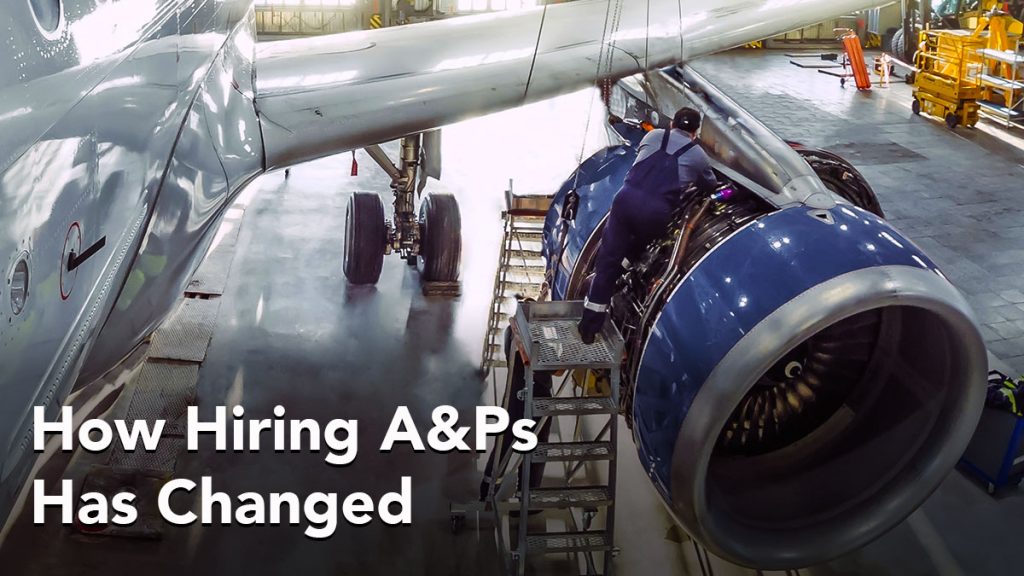
The aviation industry has seen significant changes in the past few years. Hiring A&Ps and aviation technicians is no exception. With more money-driven candidates, increased job mobility, and a large number of experienced mechanics retiring, FBOs, MROs, and other aviation employers are experiencing a shift in the talent market.
More Money-Driven
Pay has always been a major factor when selecting a new job. But, A&P candidates are increasingly placing more focus on the dollars that come with the job. They often want to know the pay rate and benefits package upfront before even considering a role. This is commonly the first question they ask during the recruitment process. While it can be easy to degrade candidates for focusing on the money, we must consider that “paying the bills” is usually the main purpose a job serves.
The numbers-first trend has created a challenge for employers as they try to find the right balance between compensation and job requirements. We find that an employer does not have to offer the most money in the industry, but they do need to be squarely in the average pay for the role if they hope to attract talent. We see that new employees may come for the money, but stay for the corporate culture. Both are important and need to be addressed for recruiting and retention.
Greater Job Mobility
Mechanics are willing to move to new jobs to find the right pay, corporate culture, and job conditions. This job mobility trend is driven by a desire for better work-life balance, higher compensation, and more opportunities for career advancement. The days of candidates being worried that frequent job moves will be perceived negatively by employers is over. Staying in a role for 10 or more years seems to be the exception and not the rule. Aviation employers must be prepared to cater to this trend by providing more flexible work arrangements and competitive compensation packages to maintain their current workforce.
Experienced A&Ps are Retiring
The aviation industry is facing a significant challenge due to the retirement of experienced mechanics. With years of experience and expertise, these mechanics have been the backbone of the industry for a long time. However, the industry is now witnessing a massive exodus of these experienced mechanics as they reach retirement age.
As A&Ps retire, younger mechanics are getting opportunities to quickly advance their skills and seniority. This is a positive development for the younger generation, as they can take on more challenging roles and responsibilities. Additionally, the industry can benefit from the fresh perspectives and ideas of younger mechanics. Employers must be proactive in their search for new talent and explore new ways to attract, integrate, and retain talent with fewer years of experience in the industry.
Airlines Grabbing up Mechanics
The main employer of aviation technicians and A&Ps is, of course, the airlines. They are feeling the A&P shortage in a major way and have reacted with an all out blitz to attract mechanics. This is causing a definitive impact on the compensation rate and availability of mechanics across the industry.
A United Airlines ad recently offered a $50,000 to $75,000 signing bonus, $25,000 relocation bonus, and a starting pay of $40.51 for a maintenance position in one of their West Coast locations. This offer shows the level of competition for skilled mechanics in the industry and the lengths to which the airlines will go to hire the maintenance personnel they need.
Moving for Both Climate and Political Reasons
Mechanics have always selected job locations based on climate, but now political reasons are coming into play. Mechanics are turning down offers because the local political climate does not fit their personal preferences. Conversely, they will request locations based on how they perceive the region’s politics.
This trend has added a new layer of complexity for companies who must consider the political climate when sourcing candidates. Employers have always talked about climate, cost of living, and quality of life in their area. Now they should be prepared to carefully navigate possible political questions as well.
Conclusion
In conclusion, the aviation industry is experiencing significant changes in the talent market for A&Ps. Employers must be prepared to cater to the changing demands of candidates who are more money-driven and mobile. They must also be more proactive in their search for new talent as experienced mechanics retire. By staying ahead of these trends, aviation employers can successfully navigate the changing landscape of the talent market.